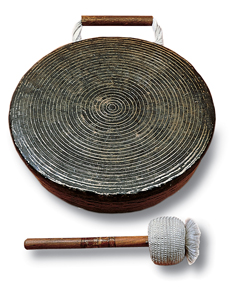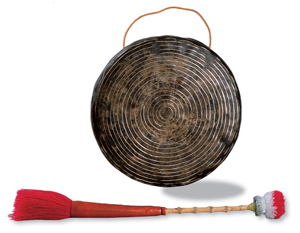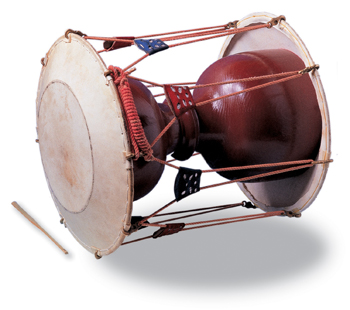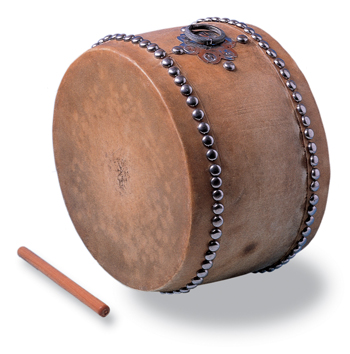|
|
|
 |
 |
 |
 |
| |
Percussion instruments are played by striking the instrument with tools. There are two different kinds of percussion instruments. Some have fixed notes such as the pyeonjong, pyeongyeong, teukgyeong, banghyang, and ulla. Others are without fixed notes such as the janggu, buk, kkwaenggwari, etc. Also, percussion instruments can be grouped into two sorts depending on the materials of the instruments. Those made of leather include the janggu, jwago and the tabla and those made of metal or wood include the pyeonjong and eo. Percussion instruments exhibit the most variety among Korean traditional music instruments. However, many of these became obsolete as some of the court ritual have been no longer observed.
 1. Kkwaenggwari (꽹과리) 1. Kkwaenggwari (꽹과리)
The kkwaenggwari is a metal percussion instrument and is played by striking the instrument with a wooden hammer. It plays the role of conductor in pungmulnori.
|
 |
 2. Jing (징) 2. Jing (징)
The jing is larger in its size than the kkwaenggwari and has been widely used among common people and in Buddhist temples. It is called the jing in pungmulnori and daegeum (a large metal) in jongmyojeryeak (Royal Ancestral Shrine Music).It is played by striking the instrument with a cloth-covered hammer held by one hand.
|
 |
 3.Janggu (장구) 3.Janggu (장구)
The janggu is an hourglass-shaped drum with two heads that are covered with leather. The right end is struck with a thin bamboo stick and the left side is hit by a left hand or by a bamboo stick with a round end. It is one of the indispensible instruments in Korean traditional music that sustains the rhythmic flow of music. It is widely used in accompaniment to court music, instrumental music and vocal music. It is also played in pungmulnori and shaman music.
|
 |
 4.Buk (북) 4.Buk (북)
Various kinds of buk are categorized according to their use. Pungmulbuk are used for pungmulnori, soribuk as an accompaniment to singing pansori and yonggo for daechwita. The buk is a wooden drum with both sides covered with leather. It is played by striking the instrument with a wooden stick.
|
|
|
|
 |
|
|
 |
|
 |
 |
 |
 |
|
|
|
|